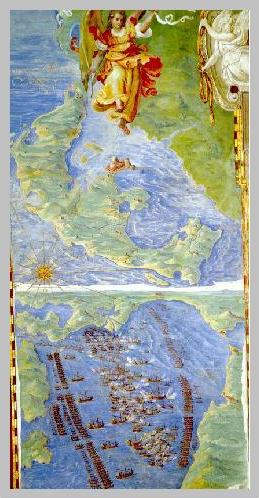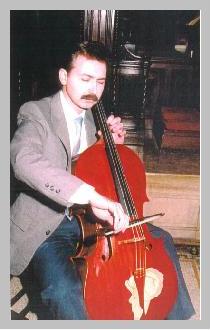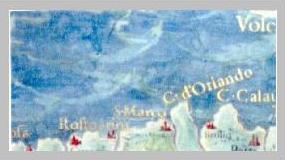
Traditional Sicilian puppets-picture taken in Sicilia
in 1999.
| Prev Page | Prev Item | Contents | Index | Home Page | Next Item | Next Page |
Page 9 of 107
THE POSSIBLE DERIVATION
OF THE NAME
COLLORAFI or COLLORAFFI
"The really valuable method of thought to arrive at
a logically coherent system
is intuition" Albert Einstein
There are many stories about the meaning of our name and how we came to be called Famiglia Colloraffi. My father said that it meant "rough hill", and it may have meant that, but I don't think so. We know that "collina" is the Italian word for "hill". One of our family members, from Librizzi told us that "rofe" or "rofi" is used by the Sicilians of that area to mean "rough".
My father told the story that the family originally lived in the mountains of the Alps and that they got in trouble for defending the family honor and were banished from the mainland and came to Sicily. He said that "rough hill" was a reference to the Alps. He provided support by telling of family members with blond hair, blue or green eyes, and light skin. He said that this is the story that he heard from his father. I was told nearly the identical story by another part of our family that branched off from mine over 200 years ago!
However, there are some historical difficulties with this legend. For one thing, many people in northeast Sicily, where our family lived, have the racial characteristics of the Normans (Norse or North men) who settled that area. The Norman invasion of 1071, which is celebrated and told in puppet shows throughout Sicily for 900 years, brought Christianity back to the island.

Traditional Sicilian puppets-picture taken in Sicilia
in 1999.
This was accomplished by the Norman Count Roger I de Hauteville.
Indeed, the remains of his mother, Queen Adelasia, are
entombed in the Cattedrale di San Bartolomeo in Patti! Furthermore, my
father had never been to Sicily and he did not know that the rugged Nebrodi
mountain range, which includes Mt. Etna, provides the background for the
homes of all of our Colloraffi ancestors.

The harbor of Corfu, around 1500, from the Vatican
Map Room.
When he thought of mountains, he thought of the Alps. In that case, why wouldn't our name reflect the Italian or Sicilian word for "mountain" rather than the word for "hill"?
Another branch of our family was told that the Colloraffis had come from Greece - either Crete or Corfu - to Patti. When this happened, if it did, is not known. One clue that this immigration did occur is in the possible Greek origins of our name. Our name might derive, at least in part, from the Greek word for a baked round bread, called "kolura" - which is related to the Latin and Italian words for "heat". "Cullura" or "Collura" or "Colura" is the Sicilian equivalent, since no "k"s are used in the Latin - based language. In the book, Nikos Kazantzakis Report to Greco, translated from the Greek by P. A. Bien, we read on pages 11 and 12, "koulouri...Donut-shaped rolls sprinkled with sesame seeds. They are sold in the street by men or boys and are a Greek institution." We also learn of the ending "aki", which is added to a word to denote "small". It is not unusual, even today, for Sicilians from the North East section of the island, where our family lived to call someone by the ending "chia" or "cia", which is a distortion of this Greek ending. My grandmother was known as Mariacia. Furthermore, we received a letter from a woman in Sicilia whose last name is Colloraffici - who tells us that this name is closer to the original surname than the Collorafi or Colloraffi version. She believed that we are from the same family. We also know that throughout the centuries, there was a great deal of trade between Greece and Sicily. This is shown, for example, by the fact that the official language of Corfu, until 1850, was Italian.
Between the 14th and 16th centuries a number of Albanians fled the Turks and moved into Greece. From there, as the Turks advanced, they fled to Sicily. This ethnic minority in Sicily is know as the Arberesh. There seems to be no evidence that the Colloraffi family is part of this migration. However, the local dialect of the northeastern part of Sicily, where our family originated, still relects the Greek influence in language, food and some customs. In fact, it is said that the town of Patti was founded by the Greeks who were defeated in the Pelopenisian Wars.

Dr. James Nicholas, who is talented in music, as well
as in languages.
One of our family members, Dr. James Nicholas, shares another theory with us. He speculates in an e-mail sent in 1998 that the name Colloraffi is a reference to a follower of Saint Nicholas. "The Italian word 'collo' means neck, but anybody whose surname begins with 'colo' or 'collo' was named, not for his neck, but for St. Nicholas 'the Wonderworker,' Archbishop of Myra in Asia Minor, one of the most beloved saints among the Greeks and among the Orthodox in general...The ending 'rofi' may be a reference to a tailor..." In Ancient Greek, 'rafeion' is a tailor's shop and 'raftis' is a tailor. This may be the case, and there were certainly many tailors in our family.
However, after three years of doing research in civil records, reading articles on Sicilian names, and discussing this with experts, I have another theory. I was advised early on in my research, by a noted Sicilian genealogist, to look to the local history of the area that our family lived in, for clues to the origination of our surname, and this is what I have done.
First of all, let me supply you with a little background as to the history of Sicilian surnames. It may surprise you to learn that only a minority of families had surnames in Sicily prior to 1750. In 1820 Napolian decreed that written records must be kept in each community of births, marriages, and deaths. This was primarily for draft and tax purposes but it also promoted using last names.
For example, in reading the census of San Piero Patti in 1681, we see people referred to by their father's name, a place name, or a nickname. (This is the reason that Rossi is the most popular surname in Sicily. It is a nickname for someone with red hair.) In this census, we see names such as "Antonio D'Antonio", "Calogero di Messina", or even "Francesco-Carmelo." A geographic feature or place of origin sometimes evolved into a surname when records were written down. My grandmother is Maria Modica and her mother is Lucia Regalbutto - both surnames are towns in Sicily.
An unusual name, one that has married into the Colloraffi
family since 1800, is Zingales Botta. How did that name come about? Zingales
Botta family members, still living in Sant' Agata di Militello, tell us
that a branch of the Zingales family came from the mountains to work as
fishermen. 'Botta' or 'Butta', as it is sometimes spelled, is Sicilian
slang for frog, which is the nickname for people who live near the sea.
So, this fishermen branch of the family was referred to as Zingales Botta,
to distinguish them from the branch living elsewhere.
There were few surnames in Renaissance Sicily. Families
with surnames, such as the famiglia Culloraffi, were usually landowners
or noblemen, who had some power in their community to collect taxes, raise
armies, employ peasants and so forth. They also owned land to be inherited,
and titles to pass on, and land records to be kept. We do see our last
name written in the 1681 and 1714 census records and in fact, know that
some of our ancestors were instrumental in writing these census records.
With this brief explanation of Sicilian surnames in mind, let us look at the evidence provided by local history of the area that we first find our ancestors.

woodcut of Archbishop Ioannes Collura.
To begin with, we find an Archbishop Ioannes Collura as ruler of the San Piero Patti /Patti area. In a record from 1709, he writes in Latin:
"To all and to each who look at these credentials,
make note of these books in which I notarize the names. I assure credibility
of all I write."
He identifies himself as "Professor of sacred theology,
Archbishop of the Universal Parish, Spiritual pastor of the land of Saint
Peter above Pactos " (Pactos is a reference to a treaty or agreement -probably
between the Turks and Normans.)
He was responsible for conducting the census of San Piero
Patti for 1714, and we even have this wood-cut picture of him.
There seems to be some evidence that our family is a
branch of the Collura family. Part of our family, from the Librizzi area,
told me that our name is a type of bread - which is true of Collura. We
also have Colloraffi family members who marry Collura's in the late 1700's
and early 1800's, and in our family, as in other Sicilian families, cousins
often married cousins - of some degree.
From the early records of our family - from the 17th century to early 18th century - we know that all of the "land owning" branches of our family marry into the Collura Famiglia. For example, Basilio Collorafi marries Donna Carmela Colura (spelled Colora) and they are the direct ancestors of the land-owning branch of Vallone Vina and San Piero Patti!
In our family, as well as other Sicilian families of the day, cousins usually married cousins of some sort in order to strengthen the family and keep land and property within it. Their children are given the noble titles of "Don" and "Donna".
If our family is part of the Collura family, it is possible that Giovani Cullurafi, born in Librizzi in 1675 is closely related to this Archbishop Ioannes Collura? "Giovani " is the Italian equivalent of the Latin "Ioannes." In the Italian religous tradition, a first name is translated into the Latin version on all legal records. We also found a record of a child born in about 1820 from a Colloraffi father, whose surname was given as Collura. The brothers, Pietro and Biagio - who are the ancestors to all of the Colloraffis who populated Sant' Agata Di Militello after 1800, had three children who married into the Collura family. Biagio was also given the title of respect "Maestro". Wouldn't it be natural to assume that our family originated as part of the Collura family that rules the "land of Saint Peter"? Our family was literate, respected, minor nobility of some sort and even helped to conduct the census. Trafford Cole, who wrote a very respected book on Italian genealogy tells us that there were only one or two landowing families in each area. In the feudal system that existed, not only did few Sicilians have surnames, but even fewer owned land - our family owned land not only in the Librizzi area, but probably in the Militello area.

closeup of a map from the Vatican Map Room
showing Rofimarini - where Sant' Agata was founded
in the mid-1600's.
Another clue, from the history of the area that our family lived, came to me, while in the Vatican Gallery of Maps, in Rome, in the year 2000. I took a photograph of the map of the area where our family had lived. I also bought several copies of 14th to 16th century maps. Sant' Agata di Militello, where my grandparents were from, did not exist.
Instead, we see the Rofi or Rofe Marianna, which is the part of the Tyrrhenian Sea, where Sant' Agata di Militello is now located, was called. We have found this on other maps from the 14th to 16th centuries. I believe that our family was the branch of the Collura Famiglia that lived near Rofe.
A less credible reason to believe this is the "computer generated" genealogy which we purchased in a Naples bookstore that states that the Colloraffi family is a branch of the noble Collura family.
It is also possible that we will never know for sure how our family name came about. Dr. James Nicolas wrote in an e -mail message in March, 2000,
"I don't think that it's a matter of IF; only WHEN. Whether they were Collura's from the Rofe area or Collo's who were Rafti's, whether they did wash over Sicilian shores from Crete or Corfu to escape the Turks swarming over Southeastern Europe, or whether they had lived in Northeastern Sicily centuries before. The overwhelming probability seems to be that they weren't any different than the rest of the populace who underwent the same thing."
Page 9 of 107
| Prev Page | Prev Item | Contents | Index | Home Page | Next Item | Next Page |